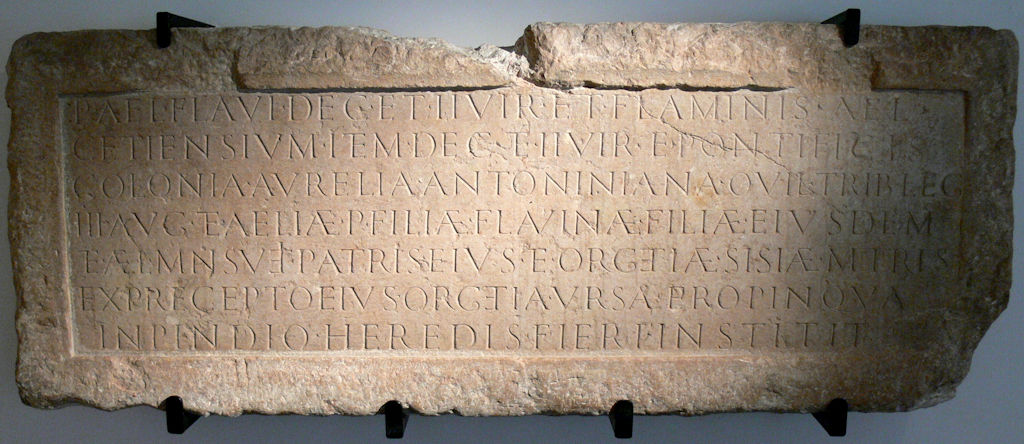Caracalla must have travelled through Noricum (roughly speaking Austria) at the end of 213 AD.
Simplified map of the lower Danube area.
Sillar 2001, fig. 8.For Ovilava (Wels, near Linz) the name Colonia Aurelia Antoniniana Ovilavensium is documented. It might derive from Caracalla, but exemplifies especially the problem of determining which Emperor Aurelius or Antoninus, of either the Antonine or Severan dynasty, gave his name. In this case the epigraphic databases give the date range 171-230 AD.

P(ubli) AEL(i) FLAVI DEC(urionis) ET IIVIR(i) ET FLAMINIS AEL(ium)
CETIENSIVM ITEM DEC(urionis) ET IIVIR(i) E(t) PONTIFICIS
COLONIA AVRELIA ANTONINIANA OVIL(avensium) TRIB(uni) LEG(ionis)
III AVG(ustae) ET AELIAE P(ubli) FILIAE FLAVINAE FILIAE EIVSDEM
ET AEL(i) MANSVETI PATRIS EIVS ET ORGETIAE SISIAE MATRIS
EX PR(a)ECEPTO EIVS ORGETIA VRSA PROPINQVA
INPENDIO HEREDIS FIERI INSTIT(u)ITFor Publius Aelius Flavius, decurio, duovir and flamen of Aelium
Cetium [Sankt Pölten], also decurio, duovir and pontifex
in the Colonia Aurelia Antoniniana Ovilava, tribune of Legio
III Augusta, and for Aelia Flavina, daughter of Publius, for the daughter of the same,
and for Aelius Mansuetus, his father, and for Orgetia Sisia, his mother.
According to his instruction ordered by Orgetia Ursa, kinswoman,
paid for by the heiress.Funerary inscription documenting the name of the colony Ovilava.
EDCS-14500927. City Museum Minoritenkloster, Wels. Photo: Wikimedia, Wolfgang Sauber.A few inscriptions document repairs of roads. Of particular importance is a milestone found near Ovilava in 1530, today lost (EDCS-14501030). The various manuscripts in which it is reported do not allow a certain reading. It has been assigned to the years 211-213 AD and says that Caracalla ordered the construction of a road along the Donau (viam iuxta amnem Danuvium fieri iussit), starting at Boiodurum (Passau in Bavaria), where the Inn and the Donau meet.
The ancient historians are silent about Pannonia. However, the Ephesian ambassador who visited Caracalla at a sanctuary of Apollo Grannos in the Rhine area met him again in Sirmium (Sremska Mitrovica, near Novi Sad in Serbia). Two praepositi annonae, officials working for the food supply, made a dedication for the well-being of Caracalla in 213 AD (EDCS-09401541). It was found in Gorsium (near Szekesfehervar, to the south-west of Budapest). Perhaps the Emperor then visited the town.
From Carnuntum (near Bratislava) comes a statue of a Genius, supported by a base with an inscription from late 212 AD. It was the work of men of the three Antonine legions of Upper Pannonia, "much devoted to Caracalla's divine majesty" (numen). It is followed by a list with the names of specialized soldiers: adjutants, secretaries, and scouts.
IMP(eratori) CAEs(ari)

M(arco) AVR(elio) ANTONINO
PIO FELICI AVGVST(o)
PART(hico) MAX(imo) BRITT(annico) MAX(imo)
PONTIF(ici) MAX(imo) TRIB(unicia) POT(estate)
XVI IMP(eratori) II CO(n)S(uli) III DESIG(nato)
IIII P(atri) P(atriae) PROCO(n)S(uli)
CORNICVLARI(i)
COMMENTARIENS(es)
SPECVLATORES
LEGIONVM III
ANTONINIANAR(um)
P(annoniae) S(uperioris) DEVOTISSIMI
NVMINI EIVS
[list of names]Marble statue of a Genius and inscription from Carnuntum.
212 AD. H. of statue 1.06, total h. 2.27.
Museum Carnuntinum. Photos: Wikimedia, Wolfgang Sauber; EDCS-28800214.A very exact date is available for the restoration by two local officials of the Temple of Nemesis in Aquincum (Budapest): the dedication is dated June 24 214 AD. The temple was old and in a bad condition. The restoration took place for the well-being of Caracalla. Nemesis dispensed both Imperial retribution and gifts.
PRO SALVTE D(omini) N(ostri)
IMP(eratoris) M(arci) AVREL(i) AN
TONINI AVG(usti)
AVRELI(i) FLORVS ET M
ERCATOR IIVIR(i) Q(uin)Q(uennales)
C[ol(oniae)] AQ(uincensium) TEMP{V}LVM
[Ne]MESIS VETVSTATE
[con]LAPSVM RESTITVER(unt)
[Mess(alla)] ET SABI(no) CO(n)S(ulibus) VIII K(alendas) IVL(ias)
[---] AVR(elio) SVRO SALA(riario)Left.
Statue of Fortuna Nemesis, holding a torch and a globe.
Next to her are a griffin and a wheel. From Aquincum.
Aquincum Museum, Budapest.
Photo: Wikimedia, Szilas.
Top.
Inscription of the restoration of the Temple of Nemesis
in Aquincum.
EDCS-29500102.From August 23 214 AD is a dedication from Intercisa (Dunaujvaros, to the south of Budapest), for the well-being and German victory of Caracalla.
PRO SALVTE ET VICTORIA
GERM(anica) IMP(eratoris) CAES(aris) M(arci) AVR(eli) SEVERI
ANTONINI PII FELICIS AVG(usti)
PARTH(ici) MAX(imi) BRIT(annici) MAX(imi) GERMANICI
MAX(imi) PONTIF(icis) MAX(imi) P(atris) P(atriae) TRIB(unicia) POT(estate)
CO(n)S(ulis) IIII DEO PATRIO SOLI ELA
GABALO MIL(ites) COH(ortis) (miliariae) HEM(esenorum) ANTON(inianae)
DEDICATVM OPVS X KAL(endas) SEP(tembres)
MESSALA ET SABINO CO(n)S(ulibus)Inscription for the well-being and German victory of Caracalla.
From Intercisa. EDCS-09900577.Also from Aquincum comes an inscription documenting a restoration of a guardhouse to protect the standards and sacred images. It is from 216 AD.
EXCVBITORIVM AD TVTEL(am)
SIGNOR(um) E(t) IMAGIN(um) SACRAR(um)
P(ublius) TVRRAN(ius) FIRMINVS VET(eranus) EX
CORNIC(ulario) LEG(ionis) II ADI(utricis) ANTO
NINIAN(a)E P(ecunia) S(ua) A SOLO RES[t(ituit)]
SABINO II E(t) ANVLLINO C[o(n)s(ulibus)]Inscription of the restoration of a
guardhouse in Aquincum.
EDCS-28600415.And still in Aquincum we see the aftermath of German campaigns. Some funerary inscriptions have been preserved of soldiers who died during the fighting or of natural causes, presumably also during the reign of Caracalla.
D(is) M(anibus)
[--- Aur(elius) ---]NVS
[---] STIP(endiorum) XXIII QVI
V[ix(it) an(nos) ---] M(enses) VII D(ies) XI DE{I}
FV(n)C(tus) EXP(editione) GERM(anica) LAVRI(aco) MORT(e)
SVA VLP(ia) FIRMILLA CONIVGI
BENE MERENTI ET AVR(elius) FIRM
ANVS PAT{E}RI RELIC(u)IAS COR
PO{I}RIS SIBI AL(l)ATAS PER FE
STUM NEPOTE(m) SV(u)M CONDID
ERVNTSarcophagus of a soldier who died during a German campaign,
in this case of natural causes, in Lauriacum (Enns, Austria).
The text is flanked by standard-bearers: an aquilifer and a vexillarius.
From Aquincum. EDCS-34100084. Photo: EDCS.In the sarcophagus of Vettia Fortunata, discovered in 1899 in Aquincum, a golden ring was found with an intaglio (amethyst) of Caracalla. The portrait has been dated to the sole reign of Caracalla, but it was inserted in the ring in the second half of the third century or later. It may then have served as an amulet. The burial was arranged by Fortunata's husband, Aurelius Hierax, a veteran of Legio II Adiutrix.
D(is) M(anibus)
AVRELIVS (h)IERAXS VET(eranus)
LEG(ionis) II ADIVTRICIS P(iae) F(idelis) ANTON
INAN(a)E VETTIAE FORTVNAT(a)E CO
NIVGI CARISSIM(a)E PIENTISSIM(a)E
FACIENDVM CVRAVITThe "Caracalla ring" of Aquincum and the inscription on the sarcophagus.
Aquincum museum. EDCS-32701076. Photos: Facsady 2011, figs. 2 and 5.